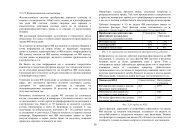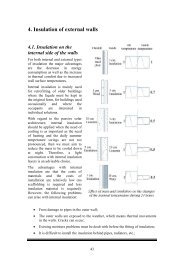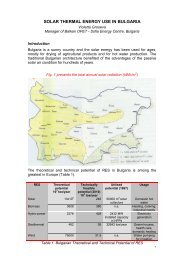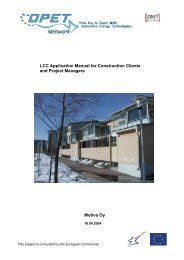Guidebook for Energy Efficiency in Municipalities
Guidebook for Energy Efficiency in Municipalities
Guidebook for Energy Efficiency in Municipalities
You also want an ePaper? Increase the reach of your titles
YUMPU automatically turns print PDFs into web optimized ePapers that Google loves.
The follow<strong>in</strong>g list <strong>in</strong><strong>for</strong>ms about the most appropriate lamp type <strong>for</strong> most applications.<br />
- For many general applications: Modern fluorescent lamps, especially the more efficient<br />
‘tri-phosphor’ lamps, have low cost, high efficiency, good colour (unlike the blue hues<br />
of older lamps) and very long life (8,000-16,000 hours rated life compared with 1,000-<br />
2,000 <strong>for</strong> <strong>in</strong>candescent lamps). They are readily available <strong>in</strong> lengths of 300-1500 mm.<br />
- For situations where there are size or style constra<strong>in</strong>ts: Compact fluorescent lamps<br />
have characteristics similar to full-sized fluorescent lamps but are suitable <strong>for</strong><br />
applications where the size or appearance of normal fluorescents is unacceptable or<br />
the high light<strong>in</strong>g output is unnecessary (e.g. desk lights, downlights, wall washers).<br />
- For light<strong>in</strong>g large areas (e.g. <strong>in</strong>door pools, depot garages): Metal halide lamps produce<br />
a crisp white light. They have efficiency about the same as the best fluorescent lamps<br />
but more light output, and so fewer fitt<strong>in</strong>gs are needed.<br />
- For situations of <strong>in</strong>frequent use: Incandescent lamps (<strong>in</strong>clud<strong>in</strong>g standard light ‘bulbs’,<br />
low-voltage and l<strong>in</strong>ear tungsten halogen lights) should only be used <strong>in</strong> fitt<strong>in</strong>gs which<br />
will be operated <strong>for</strong> less than 500 hours per year, such as cleaners’ rooms, or outside<br />
lights controlled by movement detectors.<br />
Apart from lower energy consumption, energy-efficient light sources such as fluorescents<br />
have two significant benefits, namely <strong>in</strong>creased reliability (and hence safety) and reduced<br />
ma<strong>in</strong>tenance costs (both lamps and labour). Low-voltage light<strong>in</strong>g is over-used <strong>in</strong> many<br />
office build<strong>in</strong>gs, partly because of the misconception that it is energy-efficient. Its real<br />
advantages are:<br />
- the ability to highlight a small area or object (e.g. a pa<strong>in</strong>t<strong>in</strong>g); and<br />
- small size, which can be an issue <strong>in</strong> some light<strong>in</strong>g <strong>in</strong>stallations.<br />
However, energy efficiency is not one of them, s<strong>in</strong>ce low-voltage lights are not low-power<br />
or low-energy ones. Their efficacy is about 20 lumens per watt (compared with 90-110<br />
lumens per watt <strong>for</strong> modern fluorescent light<strong>in</strong>g). The trans<strong>for</strong>mers supply<strong>in</strong>g the lowvoltage<br />
power also use energy (typically 10-20 watts per lamp) further reduc<strong>in</strong>g the<br />
efficiency of the light<strong>in</strong>g system, and this should be taken <strong>in</strong>to account when calculat<strong>in</strong>g<br />
the energy use of low-voltage light<strong>in</strong>g systems. Low-voltage light<strong>in</strong>g should not be used<br />
<strong>for</strong> light<strong>in</strong>g large areas, such as entire foyers and reception areas.<br />
Role of the fitt<strong>in</strong>g<br />
A light fitt<strong>in</strong>g (or ‘lum<strong>in</strong>aire’) should distribute the light produced by the lamp as efficiently<br />
as possible to where it is required, while m<strong>in</strong>imis<strong>in</strong>g the total cost over the life of the unit<br />
(purchase price plus energy, ma<strong>in</strong>tenance and other operat<strong>in</strong>g costs). Some per<strong>for</strong>m<br />
better than others do, as an efficient fitt<strong>in</strong>g can use half the power of an <strong>in</strong>efficient one to<br />
produce the same light output (even though they may both use the same k<strong>in</strong>d of lamp).<br />
Traditional recessed fluorescent lamp fitt<strong>in</strong>gs with acrylic plastic diffusers deliver about<br />
50% of the light produced by the lamps <strong>in</strong>to the room, while the best models, which<br />
<strong>in</strong>corporate carefully shaped reflectors, deliver more than 75% of the light produced.<br />
Fluorescent fitt<strong>in</strong>gs <strong>in</strong>clude a device called ‘ballast’, which controls lamp current. This<br />
unseen component consumes up to 10 watts per lamp, or more than a quarter of the<br />
power rat<strong>in</strong>g of the lamp itself. Modern electronic ballasts are available which:<br />
reduce the total power of the light fitt<strong>in</strong>g by about 25% while ma<strong>in</strong>ta<strong>in</strong><strong>in</strong>g light output<br />
(compared with only an 8% reduction with ‘low-loss’ iron-core ballasts);<br />
elim<strong>in</strong>ate flicker dur<strong>in</strong>g start-up and normal operation; and<br />
extend lamp life.<br />
‘Low-loss’ iron-core ballasts reduce electrical power by about 3 watts per lamp (reduc<strong>in</strong>g<br />
ballast energy use by one third compared with a standard ballast). Although the sav<strong>in</strong>gs<br />
are much lower than those of an electronic ballast, they are suitable <strong>for</strong> the replacement






